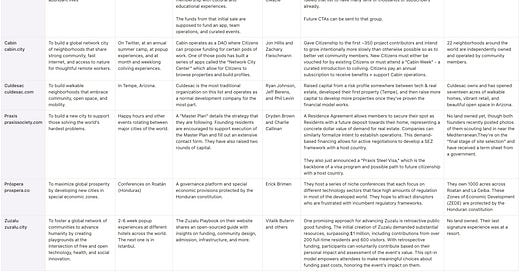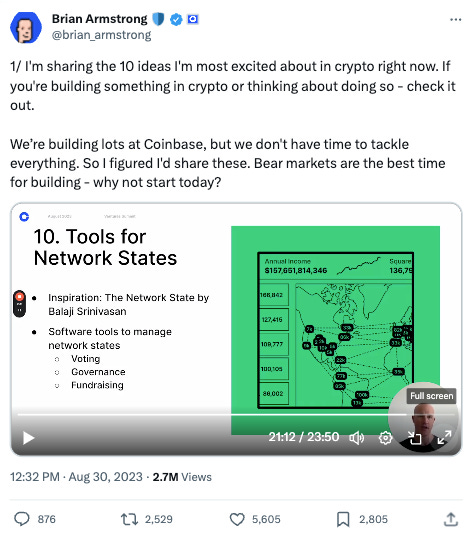The State of Network States in Fall 2023
Governments are offering term sheets and creators are filling stadiums, but there are still no startup societies close to full-fledged network state status.
If you recall from last year, the purpose of this annual report is to:
Provide analysis on how current startup societies are progressing towards becoming network states.
Observe how network state discourse has evolved.
For newer readers who aren’t familiar with the term “network state,” you can read Balaji Srinivasan’s original definition via his free online e-book.
I also attempt a simpler Jackson Plain English© definition of a network state:
A network state is a possible kind of future country that starts as an online community and eventually crowdfunds territory that provides goods & services to its citizens.
The rest of this report will include discussion of various efforts (whether consciously or not) by “startup societies” to become mature network states, and how the conversation pertaining to network states has evolved.
Note that my authorship of this report does not necessarily imply my endorsement of any particular approach that different groups are taking towards becoming network states.
Startup Societies Scorecard
Number of current fully-evolved network states with political recognition: 0
Number of startup societies tracked on thenetworkstate.com/dashboard: 24 (-2 since this same report came out last year).
Promising startup societies
Last year, I compared startup societies based on Balaji’s 11 core features of a network state. This year, I’ve chosen criteria that are more appropriate for the present moment. Some criteria from last year like “on-chain census” or “integrated cryptocurrency” aren’t yet relevant to the conversation, when most of these projects are still in a caterpillar/cocoon phase relative to the network state’s fully-fledged butterfly. So I eliminated those dimensions and added a few of my own.
Here is a brief description on each of the six dimensions through which I measure six startup societies (that may, one day, become network states).
Stated mission: What is the objective of this group and why do they exist?
Where this community gathers: Do they congregate online, in-person, or a mix of both?
Tools for collective action: How does this group coordinate?
A recognized founder: Who is the obvious leader for the project?
Growth strategy: How does this project intend to scale?
Progress towards owning land: How close are they to having people actually live on land that they own?
I’ve selected the six startup societies that I’ve seen best demonstrate progress towards Balaji’s vision of a network state this past year. What I’ve filled in is based on their marketing material, and (in some cases) direct conversations with team members. However, my degree of diligence and exposure to a startup society varies by project.

Network state discourse
Below are a few unfiltered and mostly unconnected thoughts on the broader network state discourse, outside of those six leading projects.
Varying motivations
If you read my report last year, you may remember that it was grounded in a mixture of skepticism and curiosity. This is despite (and because of) my role as a core contributor to Cabin - one of Twitter’s most well-cited examples of a startup society iterating its way towards network state status.
My skepticism towards network states is fueled by the fact that I doubt many network state projects actually need or diplomatic sovereignty, which feels very anarcho-libertarian. Of course there are serious projects for which some level of sovereignty makes sense (Próspera, Praxis, and Afropolitan). But there’s a lot of lower-rung discourse about aspiring network states that just like the idea of creating a new country because it seems fun.
My interest in network states is simple. I’m curious about them their success would imply new mechanisms for coordinating where we live and who we live with. The people we live with have the greatest influence on how we experience our day-to-day lives, and so new ways to find and gather aligned people to live together is inherently novel and interesting.
I also think that we (meaning humanity) should be experimenting constantly with new models for how we organize our built environments and governance structures. We shouldn’t be complacent and assume that our current structures are the best possible structures that could exist. Network states are an exciting frontier for both philosophical and built experiments.
Some network state curiosity interest is now financially motivated, though no business models are proven yet.
There’s a contingent of folks who see the prospect for venture-scale returns in network states, so much so that Coinbase is actively looking to support more network state startups.
Coinbase is joined by a growing number of funds and angels who are willing to consider a risk profile that is somewhere between traditional venture and a traditional real estate play (which is much less risky, historically).
It’s hard to blame these funds. Creating new cities/countries is incredibly difficult, but the ceiling is so high for success.
The challenge for network state projects will be to identify a revenue model that is sustainable without undermining any of their individual missions. The analog for this for traditional countries is paying taxes, but it would be an immense challenge to grow a citizenry by asking folks to pay taxes before your thing is even built.
Most of the folks detailed above have generated revenue to some degree, but each model has its challenges.
One-time purchases for citizenship are an easier sell, but the funds aren’t recurring so what happens when money runs out? (Afropolitan)
Coliving is a proven way to generate funds consistently, but it’s difficult to capture all of that value if you don’t own the land itself (Cabin).
Organizing conferences is also a proven way to generate value, but similarly to the above, you can’t capture most of that value if you’re paying to stay at a third-party resort that you don’t own (Zuzalu).
Developing land has outsized returns but it’s expensive and hard to do right (Shoutout to Culdesac!).
Is the Creator State the real Network State?
A core feature of Balaji’s network state is to be cloud-first, land last. “Find aligned groups of people online and then start meeting up IRL in pop-ups until there’s enough momentum and alignment to buy land.”
A recent thesis of mine is that maybe creators are the people best position to forward the network state meme. Doing so may have not ever been a creator’s original intent, but once they have a large enough audience, they are certainly at an advantage to try.
Why couldn’t the first startup society/network state to successfully crowdfund + develop land be creator-led? Already, creators like the Sidemen easily sell out 60,000+ seats for a live soccer match (not to mention the 2.5M concurrent viewers online). That’s much bigger than any IRL or virtual event that the projects above have organized.
Creators have the distribution and distinct ability to craft an engaging narrative. If a mega creator (like Mr. Beast) decides they want to buy + improve + settle a large plot of land alongside their subscribers, they are uniquely positioned to coordinate this kind of collective action challenge quickly.
Even now, leading network state projects are relying on their founders to become better content creators to attract more people to their distinct visions. Most of the founders in the table above have over 10k followers on X/Twitter (putting them in the top percentile of the platform). But their reach still pales in comparison to the reach of folks who are creators first.
Through the creator lens, a Balajian “cloud meetup” feels like a technical term to describe phenomena that already happens regularly for YouTubers and other creators. Here’s a wholesome pizza party attended by thousands when Airrack (real name: Eric Decker) hit 10,000,000 subscribers.
Mr. Beast, never to be outdone, shut down the largest mall in the USA when he launched his first brick-and-mortar burger joint. If you haven’t already seen this, I highly recommend watching the first 39 seconds of this video to understand the capacity for creators to gather people by the thousands:
All that said, I’m not recommending that we should entrust the network state experiment to creators. Not every creator meet-up goes smoothly. This is what happened in Washington Square Park when Kai Cenat announced an impromptu PlayStation 5 giveaway with little planning.
NYPD Chief Jeff Maddrey said that the event went from 300 kids to a few thousand in minutes. The area was overwhelmed and Cenat was charged with inciting a riot, despite no ill intent.
Dangerous though it may be, no current startup society could spontaneously convince thousands of people to meet up in the middle of New York in a matter of minutes. Creators have a higher collective action ceiling.
Balaji’s latest talk tracks reveal set of policy preferences
Balaji recently went on a new podcast tour in which he outlined a framework for distinguishing the “Gray Tribe” from the Red or Blue tribes.
Turpentine CEO Erik Torenberg capture a great summary of the gray tribe position here.
All I’ll add is that hearing Balaji speak makes me think that his idea of a network state might mostly be a convergence of many of his political beliefs and those of his peers. If Balaji were starting a network state today, I imagine he would construct its moral innovations to be pro-tech, pro-capitalism, anti-crime, pro-(controlled)-immigration, anti-woke, and pro-nuclear.
It’s possible that some people are attracted to the idea of a network state because they aren’t otherwise finding politicians who speak to this combination of preferences.
It may also be that since both American political parties express disdain for Big Tech that technologists are simply seeking framework and groups that support their version of pro-tech centrism. Maybe Ethereum is that natural shelling point:
Thus, I remain wary of the term “network state” because of the political baggage it could carry, because it’s overly technical to most people, and (again) because I’m not sure diplomatic recognition is the most urgent priority for these kinds of projects.
Concluding thoughts
It’s a pleasure to be able to study these projects, in all their varying states. I’m inspired by their ambition. I’ll do my best to ask thoughtful questions of these projects and share the answers here.
It feels like the early days of something big. Every other week, I feel like I see momentous tweets like this:
I won’t do anything as bold as to predict which startup society projects will have the most success (Maybe the largest one hasn’t even been started yet). Depending on the month, each of these projects seem to rotate in terms of who has the most momentum. I could point to at least one thing that each of the six projects above has accomplished this year that impressed me. I encourage them all to talk to and learn from each other.
I admire all of these teams for trying and am rooting for their success. We need more experiments in how we live, build, and coordinate with one another.










Great review. The creator point is quite interesting.
Could see something like f.inc, buildspace.so turn startup building into a creator-driven, industry-focused network state.
https://www.thomasschulz.co/ also doing interesting and related tech/AI/startups network state work without calling it that.
your chart caught my eye! I made a very similar one in my post a few months ago. Would love to collab on expanding the matrix
https://nootype.substack.com/p/exploring-emerging-coordinations